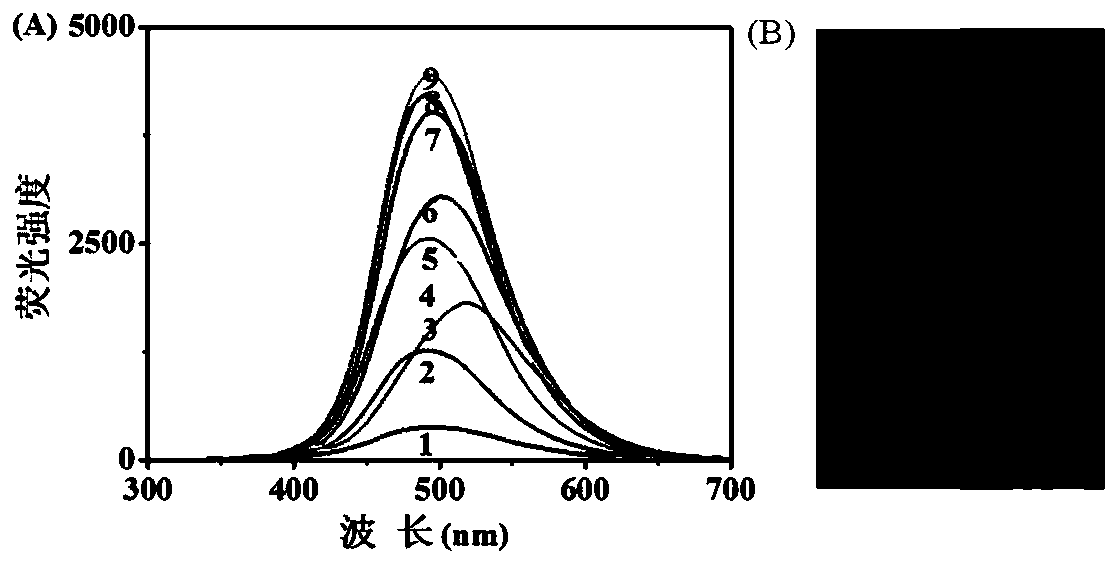Fluorescent palladium nano-cluster and synthesis method and application thereof
A synthesis method, palladium nanotechnology, applied in the field of fluorescent palladium nanoclusters and its synthesis, can solve problems such as poor stability, non-uniform nanocluster size, uncontrollable and controllable reaction conditions, etc., and achieve high stability and biocompatibility Good, the effect of shortening the detection time
- Summary
- Abstract
- Description
- Claims
- Application Information
AI Technical Summary
Problems solved by technology
Method used
Image
Examples
Embodiment 1
[0024] The preparation of embodiment 1 palladium nanocluster:
[0025] The synthesis of palladium nanoclusters, the specific operation method is: under the condition of 60 ℃, add 0.1mL palladium nitrate (100mM) solution to 2.1mL polyethyleneimine (100mM) solution, after stirring at a constant speed for 10min, add 100μL ascorbic acid ( 1.5 M) for 6h. The resulting solution was filtered through a microporous membrane with a pore size of 0.22 μm, centrifuged at 8000 rpm / min for 15 min, and dialyzed with a 1000 Da dialysis bag for 48 h to remove impurities. The resulting solution was stored at 4°C for future use.
[0026] On the F-4500 fluorescence spectrophotometer, set the excitation wavelength from 320nm-400nm, the slit is 10nm, test the emission spectrum under different excitation wavelengths (such as figure 1 A), wherein 1-9 are the fluorescence spectrum graphs under the excitation wavelengths of 320nm, 330nm, 340nm, 350nm, 360nm, 370nm, 380nm, 390nm, and 400nm respectively...
Embodiment 2
[0027] Embodiment 2 selectivity experiment to oxytetracycline
[0028] (1) The ethanol solutions containing ciprofloxacin (Cip), tetracycline (Tc), chloramphenicol (Chl) and erythromycin (Em) were respectively configured as 1×10 -4 M; The aqueous solution of amoxicillin (Amx), kanamycin sulfate (Km) is each 1 × 10 -4 M; Configuration contains the ethanol solution of oxytetracycline (Ot);
[0029] (2) Get the palladium nanocluster solution prepared in Example 1, add dropwise respectively ciprofloxacin, tetracycline, chloramphenicol, erythromycin, amoxicillin, kanamycin sulfate solution, and the ethanol solution of oxytetracycline ,carry out testing;
[0030] (3) On the F-4500 fluorescence spectrophotometer, the excitation wavelength is set to 360nm, and the slit is 10nm, and the fluorescence intensity of palladium nanoclusters at 495nm is tested. Profloxacin, erythromycin, chloramphenicol, amoxicillin, and kanamycin sulfate solution quenched the fluorescence, and only the ad...
Embodiment 3
[0031] Embodiment 3 establishes the standard curve that detects oxytetracycline
[0032] (1) Configure a series of oxytetracycline solutions with different concentrations;
[0033] (2) On F-4500 fluorescence spectrophotometer, setting excitation wavelength 360nm, slit is 10nm, gets the palladium nano-cluster solution test its fluorescence intensity as claimed in claim 1, and its emission wavelength is positioned at 495nm;
[0034] (3) Add different concentrations of oxytetracycline solution in the above-mentioned palladium nanocluster solution to test its fluorescence intensity, the fluorescence intensity of its palladium nanocluster solution decreases with the increase of oxytetracycline solution concentration, by the ratio of its fluorescence intensity I / I 0 Establish a standard curve with different concentrations of oxytetracycline solution (such as figure 2 B) (I is the fluorescence intensity of the palladium nanocluster solution measured by adding oxytetracycline solut...
PUM
 Login to View More
Login to View More Abstract
Description
Claims
Application Information
 Login to View More
Login to View More - R&D
- Intellectual Property
- Life Sciences
- Materials
- Tech Scout
- Unparalleled Data Quality
- Higher Quality Content
- 60% Fewer Hallucinations
Browse by: Latest US Patents, China's latest patents, Technical Efficacy Thesaurus, Application Domain, Technology Topic, Popular Technical Reports.
© 2025 PatSnap. All rights reserved.Legal|Privacy policy|Modern Slavery Act Transparency Statement|Sitemap|About US| Contact US: help@patsnap.com


